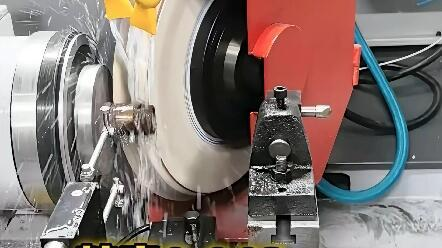How to choose and optimize the grinding process in precision parts machining?
The selection and optimization of grinding processes need to revolve around three core dimensions: part requirements, wheel characteristics, and machine tool parameters, ultimately achieving a balance between precision and efficiency.
一. Selection of Grinding Process: Matching Key Elements Based on Requirements
The core logic of the selection is: first clarify the processing requirements of the parts, and then reverse-match the type of grinding wheel, grinding method, and cooling scheme.
1.select grinding wheels based on the material and hardness of the parts
Material properties are fundamental. When machining high-hardness materials (such as quenched steel or hard alloys), it is necessary to choose grinding wheels with strong wear resistance, such as diamond wheels or CBN (cubic boron nitride) wheels.
When machining tough materials (such as stainless steel and titanium alloys), it is necessary to avoid wheel clogging. It is preferable to choose aluminum oxide grinding wheels with coarser grit and softer bonding agents to ensure smooth chip removal.
Principle of hardness matching: The higher the hardness of the part, the higher the hardness of the grinding wheel abrasive should be. At the same time, the binder needs to be more 'wear-resistant' to maintain the sharpness of the abrasive grains.
2.select the grinding method based on machining accuracy and surface quality.
Rough grinding (removing excess material): Choose a coarse-grained (e.g., 46#-80#), high-concentration grinding wheel, paired with higher grinding speed and feed rate, prioritizing efficiency.
Precision grinding (to ensure accuracy): Choose a grinding wheel with fine grit (such as 100#-200#) and a soft binder, reduce grinding speed and feed rate, in order to minimize surface burns and deformation of the parts.
Ultra-precision grinding (mirror finish): Requires the use of ultra-fine grit wheels (such as W20-W5), combined with minimal feed and special cooling methods (such as oil mist cooling), suitable for scenarios requiring ultra-high precision, such as optical components and sealing parts.
3.select the grinding method based on the part structure and machined surface select
Flat components (such as bearing housings and templates): Preferably choose a horizontal spindle surface grinder, paired with peripheral grinding or end-face grinding, to ensure a flatness error ≤ 0.001 mm.
External cylindrical parts (such as shafts and valve cores): Use an external cylindrical grinder. If high precision is required (roundness ≤ 0.0005 mm), centerless external cylindrical grinding can be chosen to reduce clamping errors.
Complex surfaces (such as mold cavities and blades): require the use of CNC forming grinders, combined with customized forming wheels, and the wheel trajectory is controlled through programming to match the surface contour.
二. Optimization of the grinding process: Reducing errors starting from parameters
The core of optimization is to reduce the impact of grinding force and grinding heat on the parts by adjusting key parameters, while also extending the lifespan of the grinding wheel.
1.Optimize grinding wheel parameters: balance sharpness and durability
Grain Size Adjustment: Coarser grains (e.g., 60#) can be used during rough grinding to reduce grinding force; finer grains (e.g., 180#) are used for fine grinding, but care should be taken to avoid excessive fineness that could cause the wheel to clog. The sharpness can be maintained through 'intermittent dressing.'
Binder selection: Resin-bonded grinding wheels are suitable for fine grinding (good elasticity, high surface quality), ceramic-bonded grinding wheels are suitable for rough grinding (high rigidity, durable), and metal-bonded grinding wheels are only used for diamond/CBN superabrasives (maintaining shape accuracy).
2.Optimize machine tool processing parameters: reduce thermal deformation and vibration
Grinding speed: For general steel parts, 30-50 m/s is recommended; if the speed is too high, it can easily cause surface burns, while if too low, efficiency will be reduced. When processing heat-sensitive materials such as titanium alloys, the speed should be reduced to 15-25 m/s and cooling should be enhanced.
Feed rate: During rough grinding, the radial feed rate should be controlled between 0.01-0.05 mm per pass. During fine grinding, it should be reduced to 0.001-0.005 mm per pass to avoid part deformation caused by excessive feed rate.
Workpiece speed: During external cylindrical grinding, the workpiece speed needs to match the wheel speed (typically, the wheel surface speed is 50-80 times the workpiece surface speed) to prevent 'spiral marks' caused by excessively low speed.
3.Optimize cooling and finishing plans: improve stability
Cooling Optimization: Use a high-pressure, high-flow cooling system (pressure ≥ 0.5 MPa) to directly spray coolant onto the grinding area, avoiding 'dry grinding'; when machining high-hardness parts, emulsified coolant (good cooling performance) can be used, and when machining tough parts, cutting oil (good lubrication) should be applied.
Grinding wheel dressing: Regularly dress the grinding wheel with a diamond pen, controlling the dressing depth at 0.001-0.002 mm. The dressing speed should be opposite to the wheel speed to ensure a flat wheel surface and reduce 'chatter' errors.
三. Key Points to Note: Avoid Common Issues
Avoid 'over-grinding': If the feed rate is too low or the grinding time is too long during the finishing stage, it can cause 'residual stress' on the surface of the part, making it prone to cracking later. Grinding volume should be controlled through 'regular dimensional checks'.
Control clamping errors: Use precision fixtures (such as three-jaw chucks or magnetic chucks), avoid clamping too tightly, and when necessary, use 'dual ejector pin' clamping (for shaft-type parts) to reduce clamping deformation.
Regular equipment maintenance: Check the precision of the grinding machine guide rails and spindle runout weekly (should be ≤0.0005mm), and calibrate the balance of the grinding wheel monthly to prevent machining errors caused by a decline in equipment accuracy.




